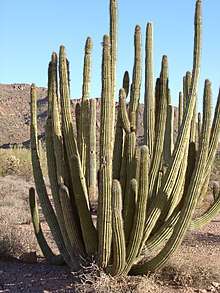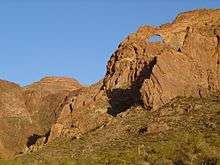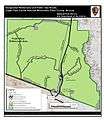Organ Pipe Cactus National Monument
| Organ Pipe Cactus National Monuments | |
|---|---|
|
IUCN category V (protected landscape/seascape) | |
 | |
 | |
| Location | Pima County, Arizona, USA |
| Nearest city | Ajo, Arizona |
| Coordinates | 31°57′14″N 112°48′03″W / 31.954°N 112.80095°WCoordinates: 31°57′14″N 112°48′03″W / 31.954°N 112.80095°W |
| Area | 330,688 acres (1,338.25 km2)[1] |
| Created | April 13, 1937 |
| Visitors | 260,534 (in 2017)[2] |
| Governing body | National Park Service |
| Website | Organ Pipe Cactus National Monument |
Organ Pipe Cactus National Monument is a U.S. National Monument and UNESCO biosphere reserve located in extreme southern Arizona that shares a border with the Mexican state of Sonora. The park is the only place in the United States where the organ pipe cactus grows wild. Along with organ pipe, many other types of cacti and other desert flora native to the Yuma Desert section of the Sonoran Desert region grow in the park. Organ Pipe Cactus National Monument is 517 square miles (1,338 square kilometers) in size. In 1976 the monument was declared a Biosphere Reserve by UNESCO, and in 1977 95% of Organ Pipe Cactus was declared a wilderness area.
Land for the Monument was donated by the Arizona state legislature to the federal government during Prohibition knowing that the north-south road would be improved and make contraband alcohol easier to import from Mexico. In 1937 the land was officially opened as a national monument.[3]
At the north entrance of the park is the unincorporated community of Why, Arizona; the town of Lukeville, Arizona, sits at the park's southern border. Lukeville is a border crossing point to Sonoyta, Sonora, Mexico.
Organ Pipe Cactus National Monument is bordered to the northwest by Cabeza Prieta National Wildlife Refuge and to the east by the Tohono O'odham Indian Reservation.
On August 9, 2002, Ranger Kris Eggle was shot and killed by a suspected Mexican drug smuggler during a United States Border Patrol operation. The visitor center has been named in his honor. The majority of the park was closed from 2003 to 2014.[4]
Gallery
 An organ pipe cactus in the Monument
An organ pipe cactus in the Monument Hedgehog cactus and brittlebush in bloom at the National Monument
Hedgehog cactus and brittlebush in bloom at the National Monument- The Monument is also home to many saguaro cacti
 The Monument also contains a pair of natural arches
The Monument also contains a pair of natural arches Map of Organ Pipe and its designated wilderness
Map of Organ Pipe and its designated wilderness
See also
- Bates Well Ranch, listed on the National Register of Historic Places within the park
- Dos Lomitas Ranch, also listed on the NRHP
- Growler Valley and Growler Mountains geographic features located within the park
- El Camino del Diablo historic road that traverses a section of the monument
References
- ↑ "Listing of acreage as of December 31, 2011". Land Resource Division, National Park Service. Retrieved 2012-05-14.
- ↑ "NPS Annual Recreation Visits Report". National Park Service. Retrieved 2018-04-02.
- ↑ "Listing of National Park System Areas by State". National Park Service. Retrieved 2011-06-30.
- ↑ After 11 years, Organ Pipe Cactus National Monument reopens
External links
| Wikimedia Commons has media related to Organ Pipe Cactus National Monument. |
| Wikivoyage has a travel guide for Organ Pipe Cactus National Monument. |